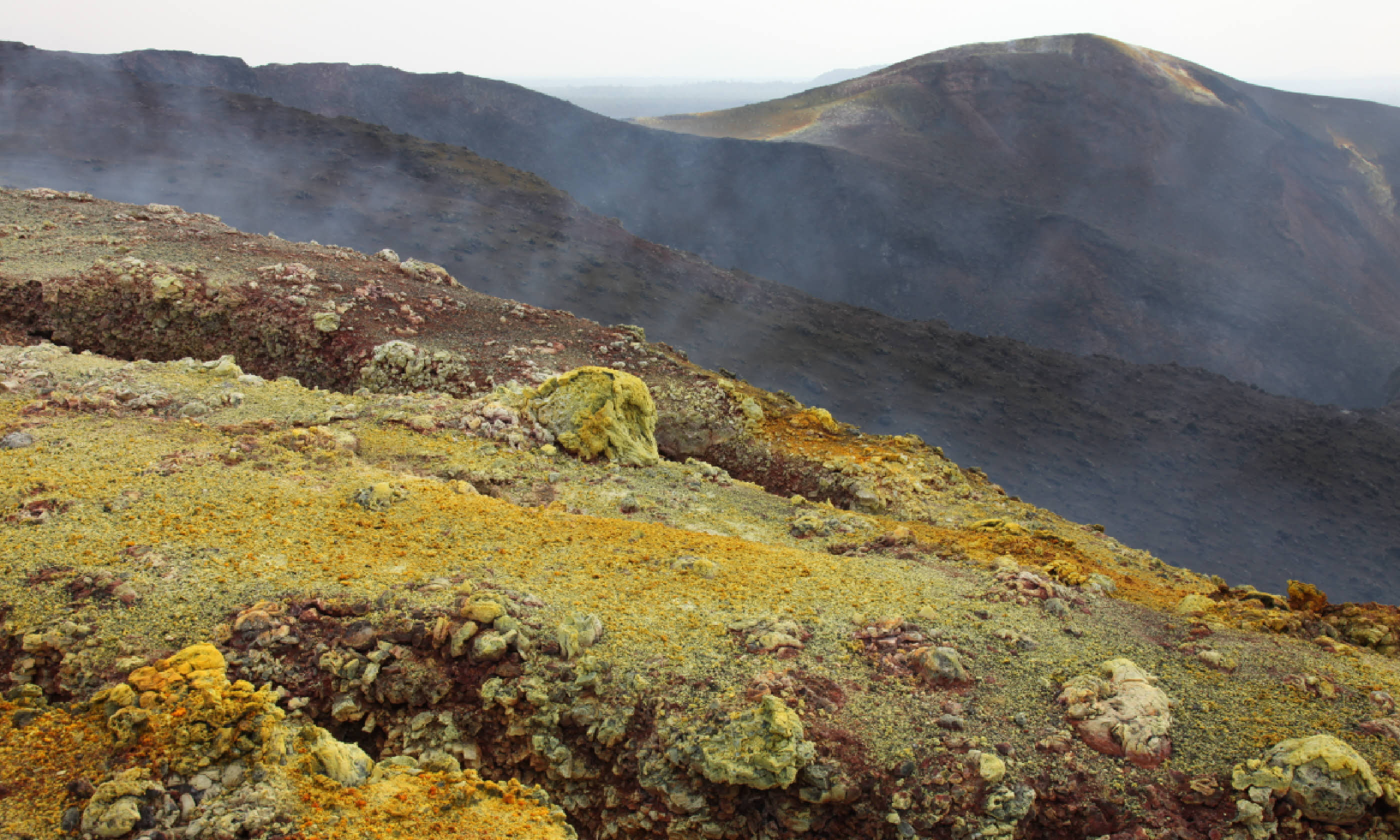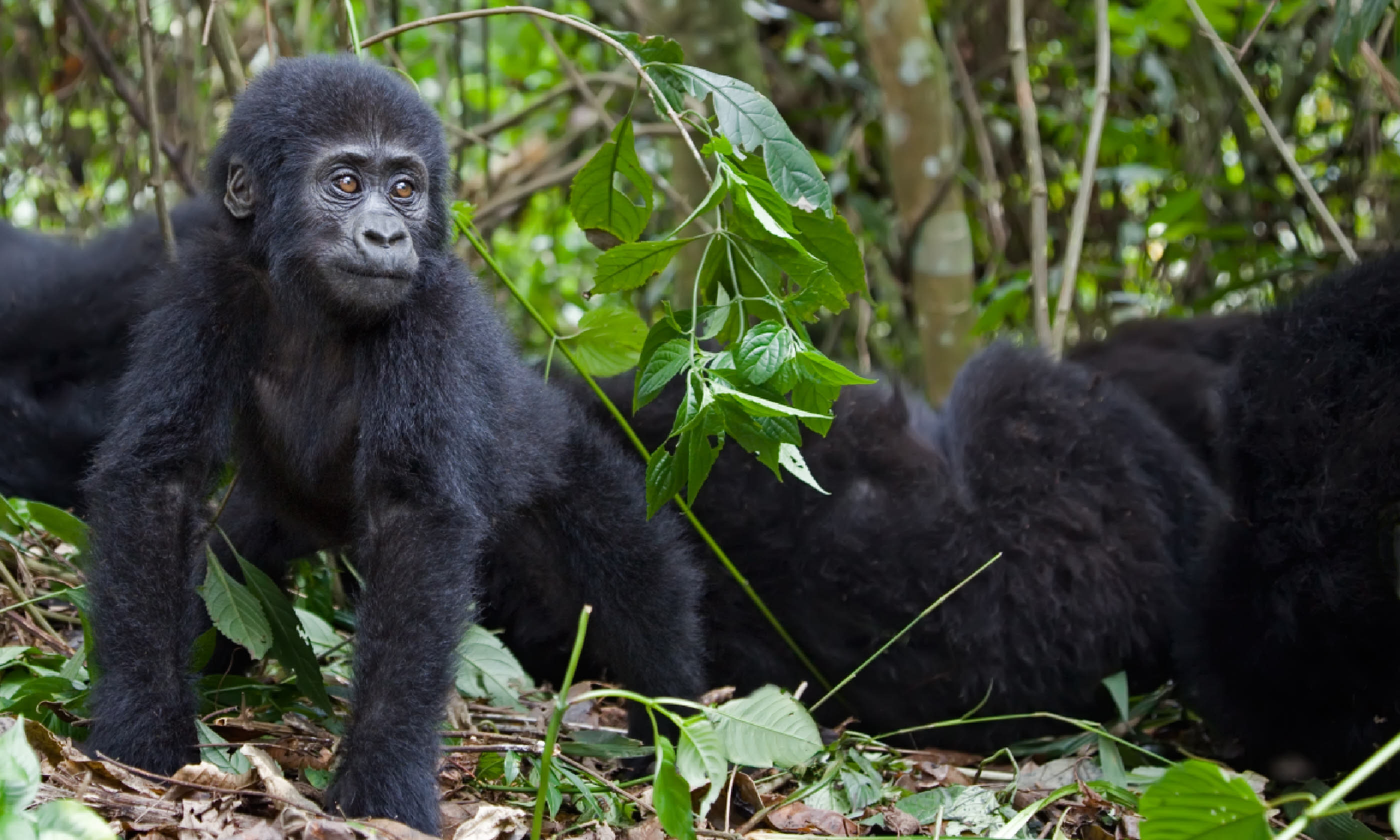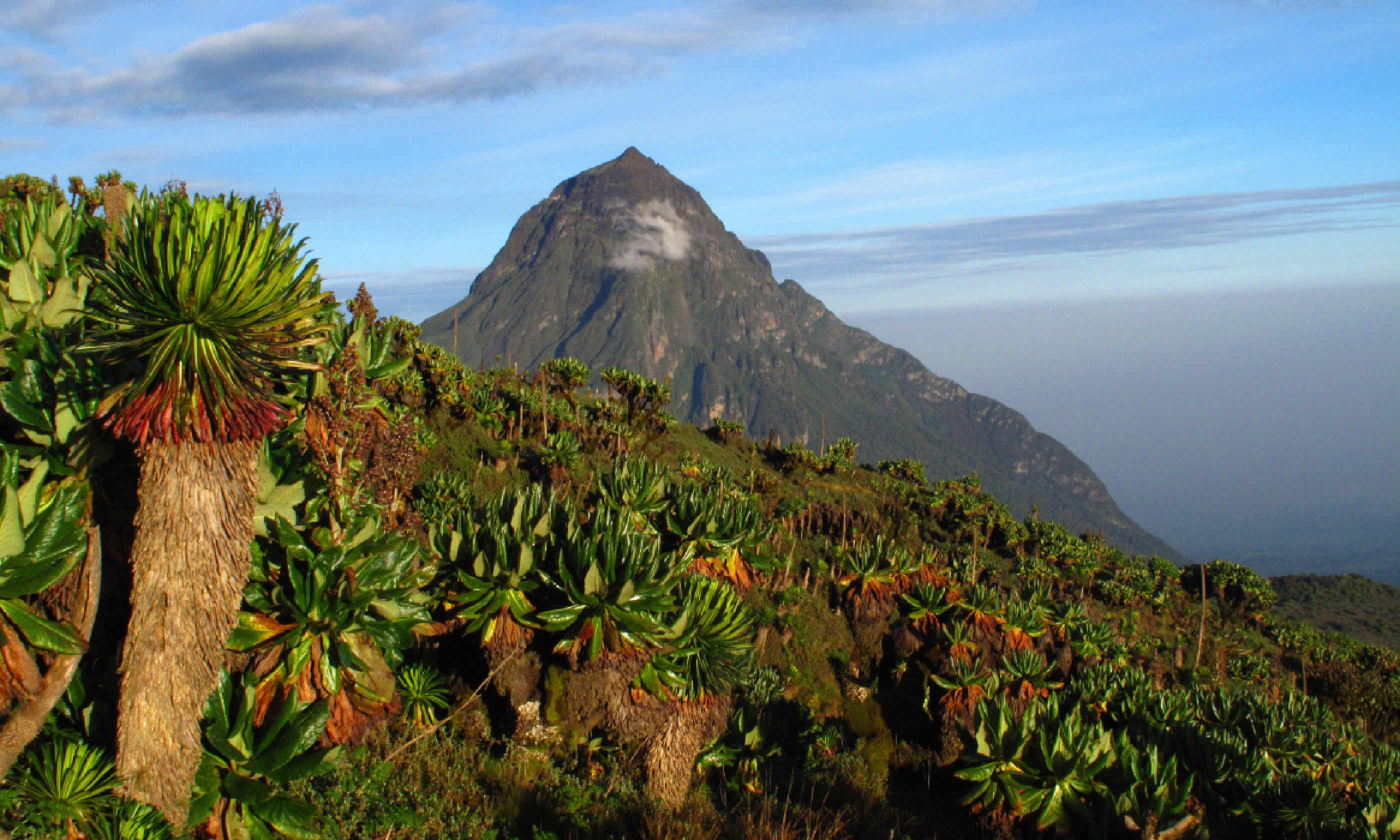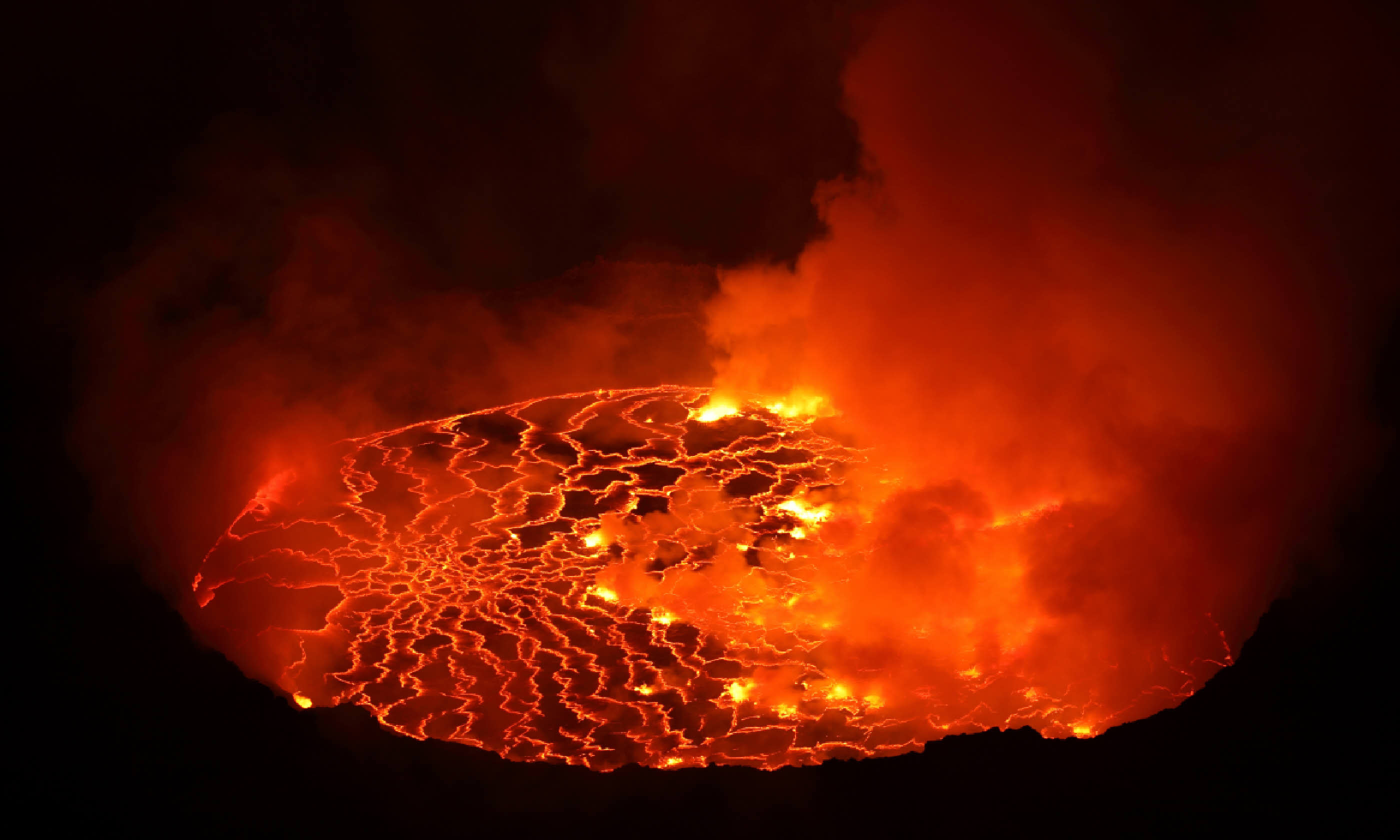
Visiting Virunga National Park, DR Congo
Vast and varied Virunga National Park is often off-limits due to conflict in the Democratic Republic of Congo. But Martin Fletcher discovers that when it is open, some of Africa’s most magical moments are found inside
We dropped down on our knees and gingerly peered over. Sheer walls plunged down into a swirling white void of mist and vapours. We could hear a roar like the sea from somewhere far below. We could feel warm air rising. We could smell sulphur, and see columns of steam escaping from fissures in the walls. But of the world’s biggest lava lake in the crater’s base we could see absolutely nothing.
We were the first travellers to tackle Nyiragongo for at least two years, and we were bitterly disappointed. But what we did not know at that moment was that within a few hours we would be spectacularly rewarded for our efforts.
Only for the brave
Nyiragongo stands in Virunga, Africa’s oldest national park and a UNESCO World Heritage site, whose 7,700 sq km encompasses snow-capped mountains, glaciers, forests, savannahs and eight volcanoes – two of them active. The park also boasts more animal species than almost anywhere else on earth, which means that within 24 hours of climbing Nyiragongo you can be standing in a tropical forest, staring into the uncannily human eyes of a huge mountain gorilla. Of the 900-or-so of those critically endangered animals left in the world, Virunga boasts roughly a third.
 Young mountain gorilla
Young mountain gorilla
For most of the past two decades Virunga has not just been closed, it’s been the epicentre of the seemingly endless conflicts that have cost five million Congolese lives and made the DRC a synonym for warfare and brutality. It has been infested by armed rebel groups that have poached its wildlife and plundered its forests. Much of it still is – and the Foreign & Commonwealth Office still advises against all travel to eastern Congo. However, since November 2013 a fragile peace has prevailed, and earlier in 2014 the park authorities re-opened its southern section.
It remains edgy, and no place for the physically frail or those of nervous disposition. But for the more robust traveller it offers the unforgettable experiences of Nyiragongo and the mountain gorillas, an almost total dearth of other tourists, and the breathtaking scenery of a raw, untamed part of Africa. Nor do you need to forsake comfort, for the park has also re-opened Mikeno Lodge, a relatively luxurious retreat in its Rumangabo headquarters complex, which was built during a lull in 2011 but mothballed when the fighting erupted anew six months later. The park’s staff took refuge in its wine cellar as artillery fire echoed all around.
Quite a ride
To reach Virunga I flew overnight from London to Nairobi where I met Mikey Carr-Hartley, a professional guide who plans to take small groups to Virunga and wanted to scout it out. Together we took a connecting flight to Kigali, capital of Rwanda, and then a three-hour taxi ride to the Congolese border town of Goma. We passed the mountains where Dian Fossey, author of
Gorillas in the Mist, worked with the greatest of the great apes for 18 years until she was murdered there in 1985. You can see mountain gorillas in Rwanda, too, but you’ll be part of a larger, regimented party and the animals are much less wild.
Crossing the border was a shock. In a hundred metres we went from the fi rst world to the third. We were met by a Virunga Land Rover and the armed rangers who, for the duration of our visit, accompanied us everywhere we went.
We drove through Goma, which is full of UN troops and NGOs, and northwards up a ribbon of rutted mud and rock and lava that was once a fine paved road. Volcanic peaks with forested flanks and shrouded summits rose to the left and right of us. People tilled fertile fields of beans, maize and potatoes. The sides of the road were lined with rudimentary wooden shacks.
The road itself was a river of humanity – colourfully dressed women carrying impossible loads on their heads, ragged children playing soccer with balls made from rolled-up plastic bags. Men pushed extraordinary wooden contraptions called
chukudus; these beasts of burden, unique to this part of eastern Congo, resemble giant children’s scooters or something out of a Flintstones cartoon. Their long running boards are attached at the front to tall upright shafts topped with handlebars like bulls’ horns. Their wheels are made from thin slices of tree trunk with strips of old tyre wrapped round their edges. They are used to transport huge bundles of timber or bamboo, great bags of cement or charcoal, scarcely credible loads of fruit or vegetables. Cheap and sturdy, chukudus are masterpieces of improvisation built to cope with conditions unlike those anywhere else in the world.
We saw army emplacements too, and a piece of heavy artillery abandoned by some militia, and the spot where Emmanuel de Merode, Virunga’s director, was ambushed and seriously injured by unknown gunmen in April. The British-educated Belgian has made many enemies since he was brought in to regenerate the park in 2008: the armed groups that still inhabit its northern and central sectors; the poachers who have killed thousands of its elephants and hippopotami; those who cut down its forests for charcoal; even a British company called Soco whose search for oil in Virunga he has fiercely opposed.
We eventually turned on to a dirt track that wound high up into the mountains and was almost impassable, even in a 4WD. For another excruciating hour we clung to the vehicle’s straps as it lurched from side to side, chased by barefooted children dressed in Oxfam cast-offs, past mud-and-bamboo huts with banana-leaf roofs. Finally, mercifully, we reached Virunga’s new Bukima tented camp. It was worth the journey.
Bukima was hardly glamping, but the tents were clean, dry and comfortable, and enjoyed spectacular views across a green valley to no less than three mist-swathed volcanoes – Mikeno, which is extinct, and Nyiragongo and Nyamuragira, which emphatically are not. They have erupted more than 70 times since the 1880s, and clouds of white vapour billowed from their cones. As night fell we sat around a fire and drank fine Congolese beer – a legacy from the DRC’s days as a Belgian colony – ate a good if basic dinner, then fell asleep in this strange, exotic land.
The magic hour
Early the next morning our rangers explained the rules for watching mountain gorillas. We could stay one hour only. We had to keep our distance and wear face masks to spare them from infection. We should avoid eye contact. No flash photography.
Several groups live on Mikeno’s forested flanks. De Merode calls their survival during two decades of warfare “the greatest miracle in modern conservation”, and credits his rangers who ventured out almost daily to monitor them, with or without the rebel groups’ approval. In all, some 140 rangers lost their lives protecting the park.
 Mikeno volcano – DR Congo (Shutterstock)
Mikeno volcano – DR Congo (Shutterstock)
They still monitor the gorillas, and the group they had earmarked for us required a pleasant hike across the sunny valley to the foot of the forest. We then scrambled up a dry riverbed through a lush-green tunnel of trees and ferns, vines and creepers, scattering butterflies in our wake. After 30 minutes, we met three more rangers who told us to put on our masks. As we did so a young male gorilla emerged from the dense undergrowth behind us, stared for a moment, then loped off on all fours. We were astounded.
The next hour was magical. We watched a 180kg silverback called Nyakamwe, the patriarch of this group of nine, nonchalantly munching leaves as he sized us up. Younger males beat their chests as our guides made grunting noises to reassure them. The youngest gorillas playfully fought, rolled on their backs, did somersaults or climbed trees as their mothers looked on. One performed a perfect pirouette as he brushed right past us.
They regarded us with almost as much curiosity as we regarded them. Some showed interest in our camera lenses, perhaps because they could see their own reflections. They were astonishingly human – not just in their facial expressions and dexterous use of fingers and thumbs, but in their conduct. They displayed affection, petulance, playfulness, mischief, boredom, protectiveness and even humour. Some were quite clearly showing off.
Watching them was unlike watching any other creature. You could sense the almost human intelligence behind their eyes. You felt an unmistakable connection, a deep sense of kinship, which was hardly surprising as the family tree split a mere nine million years ago and gorillas are some of man’s closest relatives. We were so utterly absorbed that our hour passed in a flash.
Late that afternoon we reached Mikeno Lodge, a huge thatched affair built on a wooded hilltop and surrounded by handsome guest cottages. Written instructions advised: ‘If you hear prolonged gunfire stay in your bungalow, turn off the lights and our rangers will come and collect you’.
This time we had evening drinks on our tennis-court sized deck, with monkeys cavorting in the trees and fine views across a forested plain. Being almost the only guests, we dined with Richard and Gilly Thornycroft, a charming couple of former Zimbabwean farmers brought in to run the lodge and develop the tourism that Virunga desperately needs to rebuild itself. We returned to our cottages in a pitch-black African night to find log fires burning in the grates.
Into the volcano
Rumangabo has other attractions – hikes to a coffee farm, chimpanzee-watching, and the world’s only sanctuary for orphaned gorillas, which presently has four young residents. It is also within striking distance of Nyiragongo. Check in advance that the volcano trek is possible, but if the security situation allows, it is unmissable.
We drove to Nyiragongo’s base. There we were joined by seven rangers armed with AK-47s to protect us against rebels from the infamous FDLR militia who are still camped on the far side of the volcano. We also took no less than ten porters, most wearing rags and pathetic plastic shoes, to carry our tents, sleeping bags, food and water. We felt embarrassingly like Livingstone or Stanley.
We set off for the summit shortly after noon, walking gently upwards through tropical forest. We crossed lava fields deposited when Nyiragongo last erupted in 2002, and now covered with wild flowers amid the odd charred tree trunk. As we climbed, the gradient grew steadily steeper, the temperature plummeted and the green valleys below us vanished into the haze. Eventually we emerged from thickets of giant lobelia and heather trees on to the black cone itself – a near vertical wall of jet-black lava devoid of any vegetation save odd clumps of tiny yellow flowers.
To climb so far and discover we could not see the lava lake was disappointing, but we had no time to mope. Night was approaching. It was too cold to stand around. The park had long ago built eight tourist huts on a ledge below the rim, but their roofs had been lost to gales and their metal frames eroded by sulphurous fumes so we pitched tents instead. Watched by two black ravens, the only other life on that barren peak, we heated food on a charcoal fire. We ate it beside a cross commemorating a Chinese lady who fell into the crater in 2007. It seemed a truly desolate, godforsaken place.
Then someone exclaimed. We looked up. There was an orange glow above the crater. We scrambled to our feet, peered over the rim and gasped. The mist had vanished. Far below us a great cauldron of magma several hundred metres across boiled and bubbled in the darkness. Its surface was riven by deep-red veins and mini-eruptions of molten lava that flared and flamed before subsiding. It resembled some hideous living entity, a malevolent being possessed of enormous latent energy and power. It was like a fiery vision of Hades. “The devil lives down there,” a porter solemnly declared. We watched, awestruck and utterly mesmerised, until eventually the extreme cold drove us to our sleeping bags.
 Nyiragongo Volcano, Democratic Republic Congo (Shutterstock)
Nyiragongo Volcano, Democratic Republic Congo (Shutterstock)
By dawn the mist had returned. The lava lake had vanished like a dream. It was, we reckoned, an apt metaphor for Virunga, a park that has long offered brief, tantalising glimpses of its treasures to the outside world but quickly closed up again. It is open now, but whether its gorillas attract, or guerillas repel, tourists in the future is anyone’s guess.
Make it happen
The author was a guest of
The Safari Collection and
Kenya Airways. The Safari Collection offers a three-night privately guided trip to Virunga NP, including transport from Kigali, accommodation, permits and meals, but not flights.
For further information on booking independently, contact
Virunga’s tourism office.
There are no international flights to Goma, and flying from Kinshasa to Goma on domestic airlines is not advised. The best route is to fly overnight from London to Nairobi on Kenya Airways (8.5hrs) and catch a connecting flight to Kigali, Rwanda (1.5hrs).
Public transport in eastern DRC is not recommended. Rely on Virunga’s transport or a reputable taxi company.



